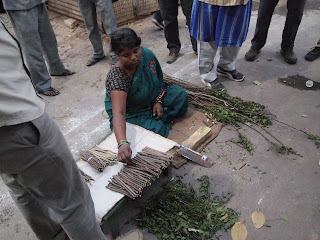Another early- AM wakeup call, this time at 5. Blah.
As usual, there was a very good reason for it. We arrived at the banks of the Ganges just as
the sun was rising. It was an
extraordinary scene- people bathing in the water (sometimes multiple times so
that others who weren’t with them would also be blessed), monks, people getting
their hair shorn, shops selling plastic pots to bring water home (because
Ganges water is considered holy),
flowers for offerings, neatly-trimmed neem tree twigs to be used as
toothbrushes, and even boxed underwear, presumably to put on after bathing in
the Ganges.
 |
| Neem twigs for sale. Neem oil is also used as an environmentally-friendly pesticide. |
 |
| This vendor was selling patties of dried cow dung, used for heating and cooking. |
The faithful bathing in the Ganges. Some do this daily, although the fecal coliform bacteria content is 9-20 X acceptable levels according to a newspaper article I later read.
The picture above is an example of how even children are taught to "hustle" early in order to survive. She was dressed as a goddess and when Mary Beth was taking my picture, she stuck to my side and would not budge even though I told her to go away. I knew what was coming next. She demanded money because we took her picture. I wasn't going to give her any but Mary Beth did.
The river was cleaner than I expected due to recent cleanup
efforts- no floating garbage or sewage and no smell. I’d told the guide that I wanted to scatter
some of Ron’s ashes in the Ganges. We
had a Hindu priest with us. I was a bit
uncertain about that- we’re not Hindu- but I realized later how wonderful it
was to deposit Ron’s ashes publicly in a place where it was not only legal, but
a respected way to honor your dead. The
priest gave me a small plate made of pressed leaves and filled with flowers; I
sprinkled a pile of Ron’s ashes on top then the priest chanted texts from the
Vedas. (Over 10-15 years of training he
had to memorize 19,000 of them.) After
that I gently floated the plate into the water.
It was profound- and some of the other tour group members said it had
added to their experience, too.
Our walk back to the bus took us past a monastery, the areas
where bodies are cremated and a place our guide said had “the best chai in
India”. The shopkeeper boiled a mixture
of tea, buffalo milk, spices he ground himself against a stone, and water; the
results were delicious.
We had the afternoon off (I skipped a silk factory tour
where those who went said the merchandise was beautiful but very
expensive). A sitar performance by a
musician whose family has been performing for 400 years was an unexpected surprise
in the late afternoon. Finally, we left
for an evening cruise on the Ganges.
The evening cruise should have been the night before, but thanks to a quirk of history (the German President Frank-Walter Steinmeier was in Varanasi and no boats were permitted out on the water), it was moved to this evening. This ride was very different; there were two major nightly events on the ghats (the steps that line the Ganges). One was ritual cremation. As our boat drew near to a cremation area, our guide asked us not to take any more pictures beyond that point to respect the mourners. We watched as a group of mourners carried a body on a bamboo stretcher, draped in a bulky gold shroud, down the steps and dipped it into the Ganges. (Married women’s shrouds feature a lot of red, because it was considered preferable that the wife die before her husband.) The mourners, after buying 600 lbs. of wood, stack half of it on the pyre, lay the body on it and add the rest of the wood, obscuring the body. The chief mourner then lights the fire and within 2-3 hours the body is mostly cremated. The last large piece of the skeleton is thrown into the river.
The evening cruise should have been the night before, but thanks to a quirk of history (the German President Frank-Walter Steinmeier was in Varanasi and no boats were permitted out on the water), it was moved to this evening. This ride was very different; there were two major nightly events on the ghats (the steps that line the Ganges). One was ritual cremation. As our boat drew near to a cremation area, our guide asked us not to take any more pictures beyond that point to respect the mourners. We watched as a group of mourners carried a body on a bamboo stretcher, draped in a bulky gold shroud, down the steps and dipped it into the Ganges. (Married women’s shrouds feature a lot of red, because it was considered preferable that the wife die before her husband.) The mourners, after buying 600 lbs. of wood, stack half of it on the pyre, lay the body on it and add the rest of the wood, obscuring the body. The chief mourner then lights the fire and within 2-3 hours the body is mostly cremated. The last large piece of the skeleton is thrown into the river.
The second ceremony was one done nightly for 3,000 years: priests saying good night to the Ganges at day's end, thanking the river for all it did for the people. There were five priests, all in orange chanting from the Vedas, bells ringing, and even towers of candles held aloft, and huge crowds.
At the end of the cruise, we were given small plates made
with pressed leaves containing small flowers and a candle; we lit the candles
and floated them off into the Ganges. It was a profound end to the day.








No comments:
Post a Comment